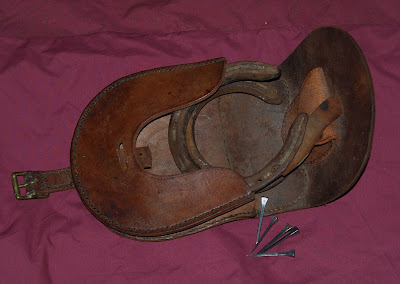

The Museum houses a collection of horse drawn farming impliments mainly of Irish origin. This mowing machine, however, is American, made by Walter A Wood of Hoosick Falls, N.Y. and is designed to be pulled by a pair of horses.
Walter A. Wood was born in Mason, New Hampshire on October 23, 1815. His father was a wagon and plough manufacturer. When he was a child the family moved to Rensselaerville, New York. During his early years, he worked in his father’s shop. At age twenty-one (1836), he moved to Hoosick Falls where he worked as a blacksmith for Parsons & Wilder. He was a blacksmith by trade and became an excellent machinist. After four years he moved to Nashville, Tennessee to work as a carriage maker. (1840)
In 1842, he moved back to Hoosick Falls and married Bessie Parsons, daughter of Seth Parsons. Seth Parsons had been his employer from 1836-1840.

Walter A. Wood purchased the Tremont Cotton Factory in 1855 to increase the production of the reaper. In 1852, he built two reapers and by 1858-59 he was producing 5,000 per year. In 1860, the plant was destroyed by fire. He immediately constructed a new plant. In July 1857, the Wood Reaper won first prize by the Syracuse Agricultural Society. In 1861, he patented the “chain rake reaper” that was so unique that it caught the attention of farmers all over the world. A mower was added as well as improvements on all the machines manufactured. By 1865, his reapers and mowers were so successful that financial people became interested in the Wood Company. In 1866, the company was organized as a stock company and called the “Walter A. Wood Mowing and Reaper Machine Company.”
The second large fire destroyed much of the Wood factory in 1870. They used the Caledonia Mill Building while the factory was being rebuilt. The output of the factory was about 8,000 units during this time. By 1890 the output had increased to approximately 90,000 units. During this time, the reapers and mowers won medals all over the world. (1862: Medal of Merit in England; 1867: Iron and Gold medal in Paris; 1873: medal in Vienna) The factory grew continuously and employment grew as Hoosick Falls prospered with the successful plant.
During the year 1878, in competitive trials, Wood's mower, reaper, and self-binding harvester took first prizes at Rome, Italy, and at fifty-four of the principal cities of England, Wales, Scotland, Belgium, Switzerland, France, Sweden, Denmark, Holland, Australia, Cape of Good Hope, Victoria, New Zealand, New South Wales, etc. From 1873 to 1877, inclusive, in 366 field-trials, these machines gained over 279 first prizes, including 88 gold medals, 64 silver medals, 8 bronze medals, 13 diplomas, 5 silver cups, and over 800 pounds in money.
We would like to thank Oliver & Rosemary for donating this mower to the Museum.

 Beside the museum are stabled our personal horses and ponies used for riding and driving, we do not, as yet, have a camel.
Beside the museum are stabled our personal horses and ponies used for riding and driving, we do not, as yet, have a camel.

 In the past cases to hold spare horseshoes were also carried on driving carriages in addition to specially made leather cases into which were fitted a set of farriers tools.
In the past cases to hold spare horseshoes were also carried on driving carriages in addition to specially made leather cases into which were fitted a set of farriers tools.



